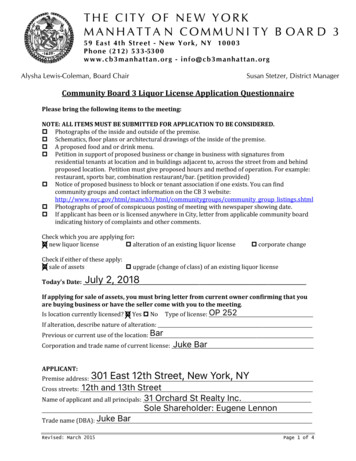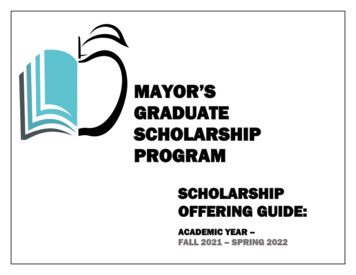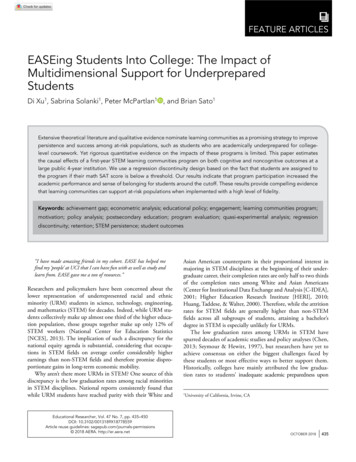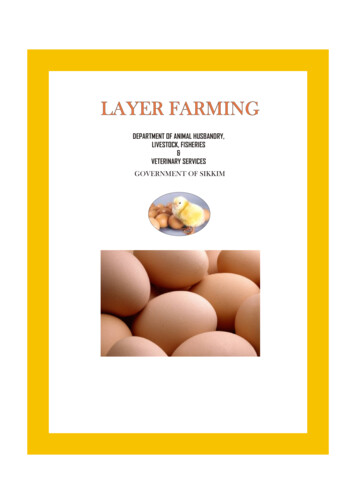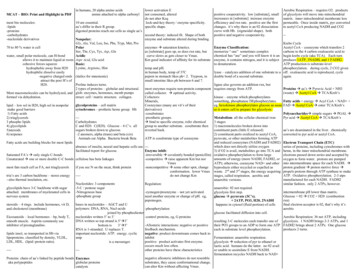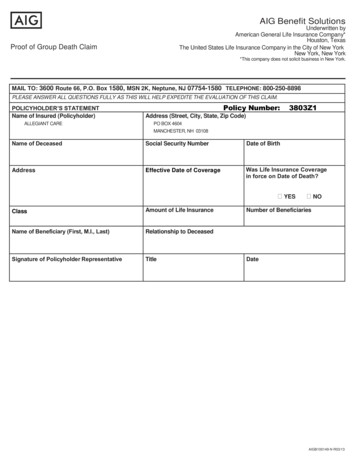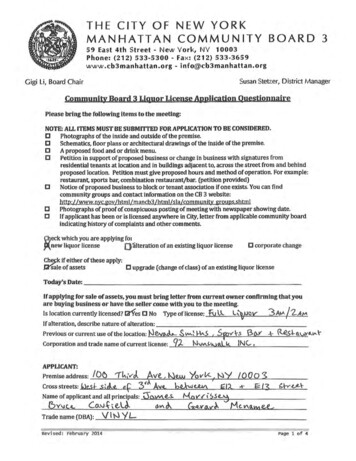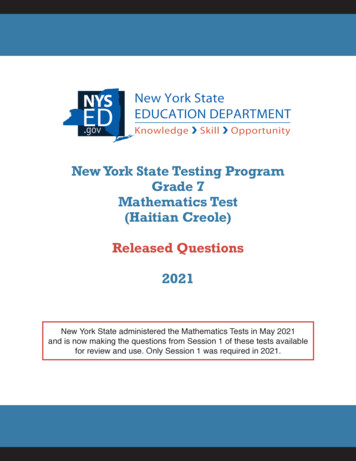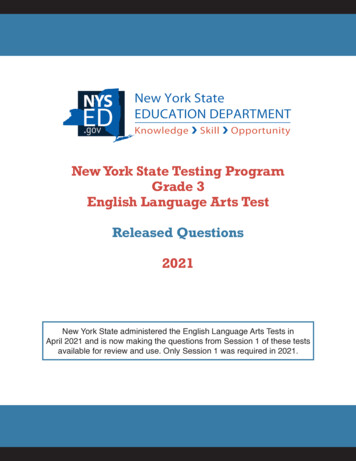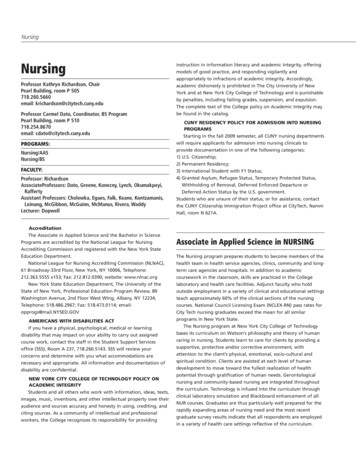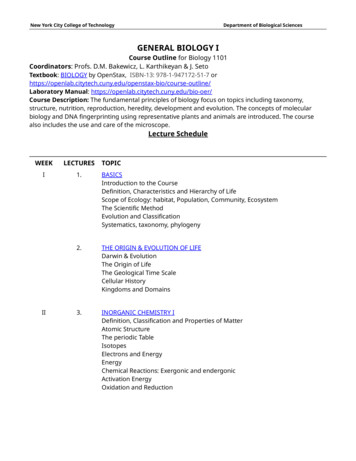
Transcription
New York City College of TechnologyDepartment of Biological SciencesGENERAL BIOLOGY ICourse Outline for Biology 1101Coordinators: Profs. D.M. Bakewicz, L. Karthikeyan & J. SetoTextbook: BIOLOGY by OpenStax, ISBN-13: 978-1-947172-51-7 ourse-outline/Laboratory Manual: https://openlab.citytech.cuny.edu/bio-oer/Course Description: The fundamental principles of biology focus on topics including taxonomy,structure, nutrition, reproduction, heredity, development and evolution. The concepts of molecularbiology and DNA fingerprinting using representative plants and animals are introduced. The coursealso includes the use and care of the microscope.Lecture ScheduleWEEKLECTURESI1.BASICSIntroduction to the CourseDefinition, Characteristics and Hierarchy of LifeScope of Ecology: habitat, Population, Community, EcosystemThe Scientific MethodEvolution and ClassificationSystematics, taxonomy, phylogeny2.THE ORIGIN & EVOLUTION OF LIFEDarwin & EvolutionThe Origin of LifeThe Geological Time ScaleCellular HistoryKingdoms and Domains3.INORGANIC CHEMISTRY IDefinition, Classification and Properties of MatterAtomic StructureThe periodic TableIsotopesElectrons and EnergyEnergyChemical Reactions: Exergonic and endergonicActivation EnergyOxidation and ReductionIITOPIC
New York City College of TechnologyIIIIVVVIDepartment of Biological Sciences4.INORGANIC CHEMISTRY IIElements, Compounds, Molecules and MixturesBonds: Weak and Strong5.WATER & pHImportance and Properties of H2OAcids, Bases, pH, Buffers6.ORGANIC CHEMISTRYImportance of CarbonOrganic vs. Inorganic CompoundsThe HydrocarbonsFunctional GroupsIsomers7.Examination I (Lectures 1-6 inclusive)8.MACROMOLECULES IMonomers and PolymersDehydration Synthesis and HydrolysisCarbohydratesLipids9.MACROMOLECULES IIProteinsNucleic AcidsATPEnzymes and Metabolic Pathways10.CELLSThe Cell TheoryMethods of Studying CellsCellular Size LimitationsCell CompositionProkaryotic and Eukaryotic CellsCellular EvolutionAnaerobic and Aerobic Cells; Endosymbiosis; Multicellularity; Viruses, Bacteriaand Archaea11.THE EUKARYOTIC CELLEukaryotic Cell Structure and Function
New York City College of TechnologyVIIVIIIIXXDepartment of Biological Sciences12.MEMBRANES & TRANSPORTMembrane Structure and FunctionPassive Transport ProcessesActive Transport ProcessesCell Surface Modifications13.Examination II (Lectures 8-12 inclusive)14.ENERGYCells and the Flow of EnergyMetabolic Reactions and Energy TransformationsMetabolic PathwaysOxidation and Reduction15.CELLULAR RESPIRATION ICellular Respiration (Anaerobic)Outside the Mitochondria: GlycolysisFermentation16.CELLULAR RESPIRATION IICellular Respiration (Aerobic)Inside the Mitochondria:The Preparatory Reaction (Hub)Citric Acid Cycle (TCA)Electron Transport Chain (ETC)Metabolic Pool17.PHOTOSYNTHESIS IPhotosynthetic OrganismsThe Process of PhotosynthesisPlant as Solar Energy Converters: Light Reactions18.PHOTOSYNTHESIS IIDark Reactions: Calvin Cycle Reactions (Carbon Fixation)Other Types of Photosynthesis19.ASEXUAL REPRODUCTIONThe Cell Cycle and Its ControlMitosis and CytokinesisThe Cell Cycle and CancerProkaryotic Cell Division
New York City College of TechnologyXIXIIXIIIDepartment of Biological Sciences20.SEXUAL REPRODUCTIONHalving the Chromosome NumberGenetic VariationThe Phases of MeiosisComparison of Meiosis and MitosisThe Human Life Cycle (Spermatogenesis & Oogenesis)21.CHROMOSOMESChanges in Chromosome Number and Structure22.Examination III (Lectures 14-21 inclusive)23.GENETICS IGregor MendelMendel’s LawHuman Genetics Disorders24.GENETICS IIExtending the Range of Mendelian GeneticsMultiple Allelic TraitsIncomplete DominancePleiotropyPolygenic InheritanceX-Linked InheritanceEnvironmental Influences25.DNAThe Genetic MaterialDNA StructureDNA ReplicationProkaryotic versus Eukaryotic Replication26.GENE FUNCTIONThe Genetic CodeTranscriptionTranslationStructure of the Eukaryotic Chromosome
New York City College of TechnologyXIVXV27.GENETIC REGULATIONProkaryoticEukaryoticRegulation Through Mutations28.BIOTECHNOLOGY & GENOMICSDNA CloningBiotechnology ProductsGene TherapyGenomics29.ANIMAL DEVELOPMENTEarly Developmental StagesDevelopmental ProcessesHuman Embryonic and Fetal Development30.Examination IV (Lectures 23-29 inclusive)Department of Biological Sciences
New York City College of TechnologyDepartment of Biological SciencesLABORATORY SCHEDULEWEEKIIIIIIIVVVIVIIVIIIIXXXIEXERCISEThe Microscope: Basic skills Scientific Method Reporting in ScienceChromatography Measurements in Science: Metric System Quantitative SkillsChemistry of Water Atoms Water pH: Acids, Bases and Buffers (activity)Biologically Important Molecules I: Carbohydrates & Lipids Basic Organic Chemistry Carbohydrates ActivityBiologically Important Molecules II: Proteins & Nucleic Acids Protein Activity Purification of DNA, Dische’s Test Review (concept map)Quantitative Determination of Proteins Beer's Law (virtual) Protein Assay (SpectroVis)Membranes and Biological Transport: Diffusion and Osmosis Size Gummy Cell Models DialysisEnzymes and Energy Enzyme Kinetics activityCellular Energy Anaerobic and Aerobic Review (concept)Photosynthesis Pigments Absorbance Spectra Light in Carbohydrate Synthesis Review (concept)Cell Division Mitosis: Estimating time of phases Chromosome Modeling Meiosis: Reduction Division and Gametogenesis Comparing Cell Division Chromosomes and Karyotypes
New York City College of TechnologyXIIGenetics Single Factor Crosses Genetics of Taste Activity Two Factor Crosses Co-dominance and Multiple AllelesXIIIPrinciples of Gel Electrophoresis Analyzing DNA Restriction EnzymesXIVDNA Fingerprinting RFLP Analysis PCR Technology ForensicsXVGenetics IIMore Genetics Problems Sex-Linked Genes Chi-Square analysis and Corn GeneticsQuizDepartment of Biological Sciences
New York City College of TechnologyDepartment of Biological SciencesCourse-Based Learning Outcomes and Alignment with General Education GoalsUpon satisfactory completion of this course, the student will be able to:BIO1101NYCCT Gen Ed Common CoreUse the arts, sciences andhumanities as a forum for the studyof values, ethical principles, and thephysical world.Engage in an in-depth, focused,and sustained program of study 1. Comprehend the principles ofbiology 2. Appreciate the relationship of theother sciences to biologyUnderstand and appreciate the rangeof academic disciplines and theirrelationship to the fields of professionaland applied study3. Understand the scientific method,its history and importance to societyEmploy scientific reasoning and logicalthinking.4. Acquire skills in the use ofbiological equipment and techniquesAcquire and use the tools needed forcommunication, inquiry, analysis, andproductive work.Acquire and use the tools neededforcommunication,inquiry,analysis, and productive work.Communicate in diverse settingsand groups, using written (bothreading and writing), oral (bothspeaking and listening), and visualmeans, and more than onelanguage. 5. Develop expertise in the writtenand oral expression of biologicalideas Derive meaning from experience,as well as gather information fromobservation.Understand and employ bothquantitativeandqualitativeanalysis to describe and solveproblems, both independently andcooperatively.Gather, interpret, evaluate, andapply information discerninglyfrom a variety of sources. 6. Gain skill in the collection of dataand in its mathematical treatmentand interpretation 7. Acquire the knowledge needed fora thorough understanding of themajor bioethical issues in society Use the arts, sciences andhumanities as a forum for thestudyofvalues,ethicalprinciples, and the physicalworld.Understand and apply fessional, civic, and cultural/global domainsCUNY Common CoreIdentify and apply the fundamentalconcepts and methods of a life or physicalscience.Apply the scientific method to explorenatural phenomena, including measurement,dataanalysis, and data presentationUse the tools of a scientific discipline ther, analyze, and interpret data andpresent it in an effective written laboratoryor fieldwork report Gather, analyze, and interpret dataand present it in an effective writtenlaboratory or fieldwork reportIdentify and apply research ethics andunbiased assessment in gathering andreporting scientific data.
New York City College of TechnologyDepartment of Biological SciencesBIOLOGY I (BY 1101) COURSE INFORMATIONMATERIALSIn addition to the lecture text and the lab manual, you will need a separate notebook for lecture andlab. For the lab, you will also need pencils, a pen, and a lab coat. These supplies can all be obtainedfrom the bookstore.ATTENDANCE AND LATENESSYou must attend both lecture and lab. Absences in excess of 10% of the total lecture or lab hours willresult in a 10% drop from your grade due to an inability to meet deliverables of participation. This is inaddition to other penalties that will be imposed for failure to complete academic requirements. Nomore than 3 lecture or 2 lab absences will be tolerated. It is expected that you will be in your seat andready to work at the start of each period. Any 2 latenesses will be considered to be equal to 1 absence.GRADING POLICYYour grade for the course is computed by adding 50% of yourlecture average to 50% of your lab average. A student must passBOTH lab and lecture in order to pass. A failure in eithercomponent will result in a final grade of F for the course. Thereare 4 lecture examinations which each cover one quarter of thelecture work as indicated in the outline; these are announced atleast one week in advance by your instructor. 60% of your labgrade is derived from your quiz average (at least 5 quizzes). 10%of the grade will be derived from at least one full scientific labLetter GradeAAB BBC CDFNumerical 76.960-69.959.9 and belowreport. The remaining 30% of your lab average is based on thequality and completeness of your lab work as indicated in the Attendance policy. ALL GRADES ARECOUNTED; NONE ARE DROPPED NOR ARE THEY CURVED. NO MAKE-UPS ARE GIVEN EXCEPT AT THEDISCRETION OF THE INSTRUCTOR PENDING SUBMISSION OF WRITTEN PROOF OF REASON FORABSENCE. All medical documentation must be submitted by the student to Student Accessibility Center(SAC) in L237 (on the second floor where the Library & General Buildings meet). SAC will review thedocumentation and provide a letter for the student to share with the instructor if accommodations arewarranted.WORKLOADConsiderable effort must be expended in order to satisfactorily complete the course. It is expected thatyou will spend at least 3 hours per week in preparation for each credit hour of course work; this is atotal of 12 hours. If you are not able to devote the requisite amount of time to your studies then youshould seriously reconsider your decision to take the course at this time.
New York City College of TechnologyDepartment of Biological SciencesACCESSIBILITYCity Tech is committed to supporting the educational goals of enrolled students with disabilities in the areasof enrollment, academic advisement, tutoring, assistive technologies and testing accommodations. If youhave or think you may have a disability, you may be eligible for reasonable accommodations or academicadjustments as provided under applicable federal, state and city laws. You may also request services fortemporary conditions or medical issues under certain circumstances. If you have questions about youreligibility or would like to seek accommodations or academic adjustments, please contact the Centrer forStudent Accessibility @ 300 Jay Street L-237. 718-260-5143.SUGGESTIONS Read the chapters BEFORE class reading ahead makes you aware of the words so the instructor can clarifyTake notes ACTIVELY in class don't rely on flipping through the slides the night before the exam your notes will not be organized on first pass so re-write them with the aid of the textbookBe AWARE of announcements ensure you check Blackboard regularly ensure you utilize you school email for additional announcements faculty make announcements and can only push to official school emailKNOW your lecture instructor and lab instructor your instructors will provide you with email contact information as well as office hours If you encounter any serious difficulties during the semester, it is suggested that you make anappointment with an instructor to discuss them.KNOW your classmates form study groups and ensure you can receive missing work from othersBe RESPONSIBLE contact your instructor if you are going to miss class or an examBe PROFESSIONAL You are in an institute of higher learning, so address your instructor as Professor and berespectful Learn to communicate by email in a professional manner. Follow the guidelines for email contact hereYou are responsible for all material, announcements, or assignments mentioned in class whether you arepresent or not. It is therefore advisable to write down the name of your instructor(s), the office, phoneextension and office hours. It is also advised to get the names and phone numbers of several classmateswho may be contacted in the event that you are absent. Check Blackboard for announcements, links andschedules from your instructor.In order to optimize your performance, it is strongly advised that you read your lecture and lab assignmentsprior to coming to class. At the end of each chapter in the text and in the lab manual review questions areavailable for you to test yourself. A Student Study Guide may be purchased along with your text book.Tutorial help in the Resource Center is usually available if additional assistance is needed.You may use the online reading guide with supplemental material athttps://openlab.citytech.cuny.edu/openstax-bio/
New York City College of TechnologyDepartment of Biological SciencesSTRATEGIES FOR LEARNINGBeing a successful learner means understanding how knowledge is acquired and utilized.Credit: Jeremy Seto (CC-BY-NC-SA)1. Remember Science is a foreign language. The first thing a student needs to do is learn the basicvocabulary. Create Flash Cards to learn vocabulary This is the base for all subsequent learning2. Understand Recalling definitions is meaningless if you can't use the terms appropriately Use the words in sentences and link related terms together Create concept maps that illustrate how terms work together Use the following tutorial to learn how to do this3. Apply Can you use the newly acquired knowledge to solve new problems? Can you follow the relationships in your concept maps to use the knowledge? Use the knowledge to identify examples and problems in every day life4. Analyze Can you break down information into components to formulate generalizations? Analysis of elements Analysis of relationships Analysis of organization Most Analysis in this course comes into play in the Laboratory where observations can bediscussed in the context of the preceding levels of knowledge.
New York City College of TechnologyDepartment of Biological SciencesTEXTBOOKLab ManualBiology (available in as PDF, online ardcopy, read-aloud ) Publisher: OpenStax College; 1st edition(January 1, 2013) ISBN-10: 1938168097 ISBN-13: 978-1938168093Laboratory InstructorLecture InstructorOffice Hours Office HoursPhonePhoneEmailEmailCourse Coordinator(s)Email(s)Classmate Name and Contact InformationClassmate Name and Contact InformationClassmate Name and Contact Information
Jan 01, 2013 · New York City College of Technology Department of Biological Sciences GENERAL BIOLOGY I Course Outline forBiology 1101 Coordinators:Profs. D.M. Bakewicz,L. Karthikeyan &J.Seto Textbook: BIOLOGY byOpenStax, ISBN-13:978-1-947172-51-7 or . TEXTBOOK Biology (
